The Indian Armed Forces have released satellite images revealing the extent of damage inflicted on terrorist infrastructure in Pakistan and Pakistan-Occupied Kashmir (PoK) during the recent Operation Sindoor. The images provide a stark 'before and after' comparison of the targeted sites, including critical locations in Muridke and Bahawalpur, along with several airfields and air defence radars deep within Pakistani territory.
Operation Sindoor was launched in response to the April 22 terror attack in Pahalgam, Jammu and Kashmir, which claimed 26 lives. The pre-dawn missile strikes on May 10 targeted nine terrorist facilities – four in Pakistan and five in PoK – housing key operational centres for groups like Lashkar-e-Taiba (LeT), Jaish-e-Mohammed (JeM), and Hizbul Mujahideen.
The strike locations included Muridke, a major LeT stronghold and its headquarters spread over approximately 200 acres, often referred to as Pakistan’s 'terror nursery'.



Air Marshal AK Bharti, addressing a press conference on Monday, highlighted the strategic significance of the strikes, stating, "It was time to convey some message to the adversary... hit where it would hurt. India’s retaliation though was precise, and measured. We have the ability to target every system in the air bases, but we showed restraint to avoid escalation."
The Indian military’s operation also targeted Pakistan’s airfields, including Rafiqui, Chaklala, Rahim Yar Khan, Sukkur, Sialkot, Pasrur, Chunian, Sargodha, Bholari, and Jacobabad. These bases, crucial to Pakistan’s air defence, suffered significant damage, marking the first known instance of a nuclear-armed state facing such deep incursions into its military infrastructure.
According to the Indian Army, the strikes have significantly degraded Pakistan’s ability to launch aerial offensives, with 11 bases attacked within a span of three hours. "Within three hours, 11 bases were attacked, including Nur Khan, Rafiqui, Murid, Sukkur, Sialkot, Pasrur, Chunian, Sargodha, Skaru, Bholari, and Jacobabad," Air Marshal Bharti added.
The strikes also targeted sites in PoK, including Muzaffarabad, Sawai Nala, Syedna Bilal, Gulpur, Kotli, Barnala, Bhimber, and Abbas, Kotli – all known for housing key militant camps and support infrastructure.
The operation comes amid heightened tensions between India and Pakistan, with multiple cross-border skirmishes reported following the missile strikes. On Saturday, explosions were reported at multiple Pakistani air bases, which were heard as far as Srinagar. Pakistan, which initially called for a ceasefire, reportedly violated it within hours, further escalating the situation.
Meanwhile, Indian military sources noted a rare moment of calm on Sunday night, with no significant ceasefire violations reported along the Line of Control (LoC) for the first time in days. "The night remained largely peaceful across Jammu and Kashmir and other areas along the International Border," the sources said.




